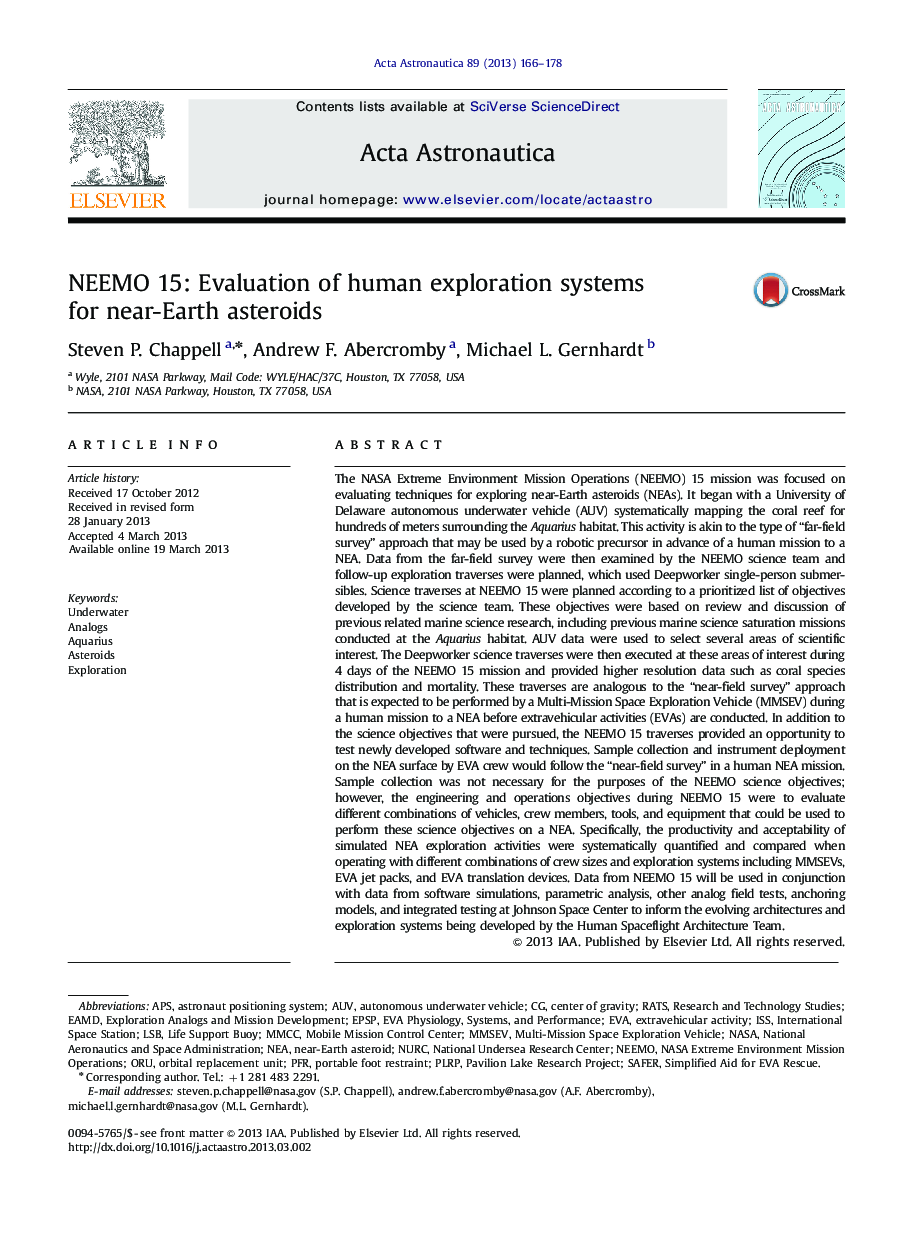| کد مقاله | کد نشریه | سال انتشار | مقاله انگلیسی | نسخه تمام متن |
|---|---|---|---|---|
| 8057112 | 1519961 | 2013 | 13 صفحه PDF | دانلود رایگان |
عنوان انگلیسی مقاله ISI
NEEMO 15: Evaluation of human exploration systems for near-Earth asteroids
دانلود مقاله + سفارش ترجمه
دانلود مقاله ISI انگلیسی
رایگان برای ایرانیان
کلمات کلیدی
PLRPAUVNEAISSEVAPFRLSBAPs - AP هاEPSP - epspiAquarius - آبشارAnalogs - آنالوگ هاSafer - امن ترInternational space station - ایستگاه فضایی بین المللیexploration - جهانگردی یا اکتشافautonomous underwater vehicle - خودرو زیر آب خودمختارUnderwater - زیر آبnational aeronautics and space administration - سازمان ملی هوانوردی و فضاییAsteroids - سیارکnear-Earth asteroid - سیارک نزدیک زمینExtravehicular activity - فعالیت خارج از چرخهcenter of gravity - مرکز گرانشRats - موش صحراییNASA - ناسا
موضوعات مرتبط
مهندسی و علوم پایه
سایر رشته های مهندسی
مهندسی هوافضا
پیش نمایش صفحه اول مقاله

چکیده انگلیسی
The NASA Extreme Environment Mission Operations (NEEMO) 15 mission was focused on evaluating techniques for exploring near-Earth asteroids (NEAs). It began with a University of Delaware autonomous underwater vehicle (AUV) systematically mapping the coral reef for hundreds of meters surrounding the Aquarius habitat. This activity is akin to the type of “far-field survey” approach that may be used by a robotic precursor in advance of a human mission to a NEA. Data from the far-field survey were then examined by the NEEMO science team and follow-up exploration traverses were planned, which used Deepworker single-person submersibles. Science traverses at NEEMO 15 were planned according to a prioritized list of objectives developed by the science team. These objectives were based on review and discussion of previous related marine science research, including previous marine science saturation missions conducted at the Aquarius habitat. AUV data were used to select several areas of scientific interest. The Deepworker science traverses were then executed at these areas of interest during 4 days of the NEEMO 15 mission and provided higher resolution data such as coral species distribution and mortality. These traverses are analogous to the “near-field survey” approach that is expected to be performed by a Multi-Mission Space Exploration Vehicle (MMSEV) during a human mission to a NEA before extravehicular activities (EVAs) are conducted. In addition to the science objectives that were pursued, the NEEMO 15 traverses provided an opportunity to test newly developed software and techniques. Sample collection and instrument deployment on the NEA surface by EVA crew would follow the “near-field survey” in a human NEA mission. Sample collection was not necessary for the purposes of the NEEMO science objectives; however, the engineering and operations objectives during NEEMO 15 were to evaluate different combinations of vehicles, crew members, tools, and equipment that could be used to perform these science objectives on a NEA. Specifically, the productivity and acceptability of simulated NEA exploration activities were systematically quantified and compared when operating with different combinations of crew sizes and exploration systems including MMSEVs, EVA jet packs, and EVA translation devices. Data from NEEMO 15 will be used in conjunction with data from software simulations, parametric analysis, other analog field tests, anchoring models, and integrated testing at Johnson Space Center to inform the evolving architectures and exploration systems being developed by the Human Spaceflight Architecture Team.
ناشر
Database: Elsevier - ScienceDirect (ساینس دایرکت)
Journal: Acta Astronautica - Volume 89, AugustâSeptember 2013, Pages 166-178
Journal: Acta Astronautica - Volume 89, AugustâSeptember 2013, Pages 166-178
نویسندگان
Steven P. Chappell, Andrew F. Abercromby, Michael L. Gernhardt,